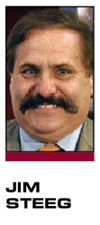Editor’s note: Jim Steeg, who for 26 years was in charge of the Super Bowl and special events for the NFL, shares his memories of Whitney Houston’s rendition of the national anthem. Houston, 48, died Feb. 11.
Just after Thanksgiving in 1987, I received a call from John Houston. It was unexpected and one of those many calls that I had learned to adjust to.
John explained that his daughter, Whitney Houston, had just fired her manager. As her new manager, he had learned that she was booked to perform the national anthem at Super Bowl XXII, which was a little more than two months away. No one else was aware of this, he said, and they had a previous commitment to tour Australia. So began a 16-year relationship with John Houston.
In 1990, as we approached the silver anniversary of the Super Bowl, we were planning many special elements. I had remembered those conversations in 1987 and reached out to John Houston to see if Whitney would be interested in performing the national anthem for Super Bowl XXV. The answer was a resounding “Yes.” Little did we know at the time what it would mean.
On Jan. 17, 1991, the United States launched Operation Desert Storm. Although it had been anticipated for weeks, the thought that the Super Bowl would be played 10 days later made everyone involved reconsider all plans. For the first time at a major sporting event in this country, the level of security was raised to the highest levels. Barricades were placed around Tampa Stadium, and attendees were patted down. The airspace over the stadium was closed to commercial use for the first time in Super Bowl history, and a Black Hawk helicopter patrolled.
In early January, Bob Best, our 20-year coordinator of Super Bowl pregame activities, produced a recording of the Florida Orchestra for national anthem producer Rickey Minor, now known for his work on “American Idol” and “The Tonight Show.” A week later, Minor flew to Los Angeles to have Whitney record the vocal track. Amazingly, as he has said, it was done in one take.
All was in place for what many of us thought would be one of the greatest versions of the national anthem ever performed. On Jan. 17, senior executives with the NFL asked if they could hear the performance. A tape was overnighted to Buffalo, where the AFC Championship Game was to be played. The next day, I was told that the version was viewed as too slow and difficult to sing along with. Could I ask to have it redone? Understanding the logistics of re-recording the Florida orchestra, Bob and I called John Houston. The conversation was brief: There would be no re-recording.
Whitney sang the anthem live into a dead microphone, while the stadium and TV audiences heard the prerecorded version. That performance is one of the top five moments in the NFL’s long history, certainly the No. 1 musical moment. I stood about 20 feet from Whitney during the national anthem, alongside Lawrence Taylor and Carl Banks. (As the Giants team captains, they were next on the schedule, for the coin toss). I remember that when the performance ended, Whitney raised her hands in triumph, and it gave me flashbacks to Joe Namath after Super Bowl III; she had “nailed it” just as Joe had.
Almost forgotten in the magnificence were the punctuation points: the flyover by four F-16s from Tampa’s MacDill Air Force Base and the surprise decision by the helicopter pilot to do his own flyover. That shook the crowd, and energized it.
In the following days, Whitney’s national anthem was played everywhere. In conjunction with Arista Records, the single was released. It was the first and only time a recording of the national anthem hit the Billboard charts, and it remained there for 11 weeks.
The proceeds from the single for Whitney — which exceeded $500,000 — were donated to the Red Cross in Hawaii for the families of the military. Jahja Ling, who was the musical director of the Florida orchestra, said the group’s proceeds ensured its financial viability for years.
The record went platinum, and one of my most cherished Super Bowl mementos is that gold record.
After 9/11, Whitney’s national anthem was re-released, and hit No. 1 on the Billboard singles charts.




